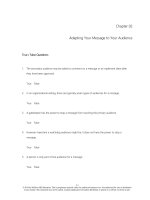Business communication building critical skill 3rd by locker module 13
Bạn đang xem bản rút gọn của tài liệu. Xem và tải ngay bản đầy đủ của tài liệu tại đây (383.37 KB, 15 trang )
PPT
PPT
Module
Module 13
13
E-Mail
E-MailMessages
Messages
and
andWeb
Web Writing
Writing
McGraw-Hill/Irwin
©2007, The McGraw-Hill Companies, All Rights
13-2
E-Mail
E-Mail Messages
Messages and
and Web
Web
Writing
Writing
♦To learn how to
Format e-mail messages.
Use e-mail effectively.
Write effective subject lines for email messages.
Manage time.
Write for the Web.
13-3
E-Mail Messages
Messages and
and Web
Web
Writing
Writing
Start by answering these questions:
How should I set up e-mail
messages?
What kinds of subject lines should I
use for e-mail messages?
Should I write e-mail messages the
same way I write paper messages?
13-4
E-Mail Messages
Messages and
and Web
Web
Writing
Writing
Start by answering these questions:
What e-mail “netiquette” rules should I
follow?
How and when should I send
attachments?
What style should I use when writing
for the Web?
13-5
E-Mail Messages
Messages and
and Web
Web
Writing
Writing
Start by answering these questions:
Can I use blogging on the job?
What other technologies use the
Internet?
13-6
E-Mail Messages
Messages and
and Web
Web
Writing
Writing
Start by answering these questions:
What e-mail “netiquette” rules should I
follow?
Should I worry about viruses?
13-7
When
When Writing
Writing E-Mail,
E-Mail, Remember
Remember
♦All principles of good business
writing still apply with e-mail.
♦While e-mail feels like talking, pay
attention to spelling and grammar.
♦You should proofread messages.
♦E-mail should interest the readers
in the subject line and first
paragraph.
13-8
E-Mail Subject
Subject Lines
Lines
♦ Are specific, concise, and catchy.
♦ Give good news in positive
messages.
♦ Give negative news when it’s
serious, the reader needs the
information to act, or you report your
own errors.
♦ Make the request clear in
persuasive messages.
13-9
For
For Proper
Proper “Netiquette,”
“Netiquette,” Never
Never
♦“Flame” your
audience.
♦Send unnecessary
e-mails.
♦Compose e-mail
messages when
you’re angry or
upset.
1310
Web
Web Writing
Writing
♦Business writing basics
apply.
Be clear, concise, and complete.
In general, keep the style simple and
conversational.
♦Readers skim.
Use short sentences and
paragraphs.
Use titles, headings and bulleted
lists.
1311
Web
Web Writing
Writing
♦Work with designers on
format.
If links seem too many, they
probably are.
Test your design with potential
users.
Images should support text.
• Avoid complex introductions
that slow loading a page.
• Tell a story with titles and
captions.
1312
Scannable
Scannable Text
Text
♦According to John Morkes and
Jakob Nielsen
Highlight key words.
Use meaningful subheadings.
Include bulleted lists.
Use one idea per paragraph.
Use “inverted pyramid” organization.
Use half the word count of a printed page.
Avoid “marketese.”
1313
Blogging
Blogging
♦Blogs can be used for business.
♦Company may own the space.
Stay professional.
Avoid deeply personal information or unflattering
opinions about the company or its employees.
♦Popular blog sites are
blogger.com and
businessblogconsulting.com.
1314
To
To Create
Create aa Blog
Blog for
for Business
Business
♦Jeff Wurio suggests
Identify your audience.
Decide where your blog should live.
Start talking.
“Blog roll,” or link to other sites and blogs.
Emphasize words.
Keep it fresh.
Watch traffic closely.
1315
Technology
Technology
♦Web-based technology
PDAs.
Cell phones.
Videoconferencing.
♦Technology changes—
be flexible—but
choose useful
technology.









